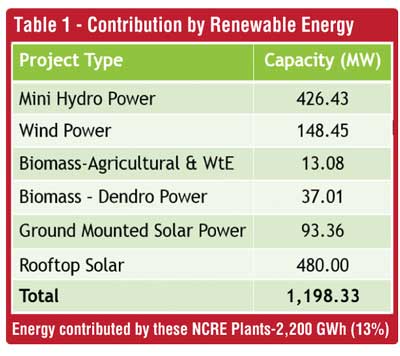Saturday Dec 06, 2025
Saturday Dec 06, 2025
Tuesday, 15 February 2022 02:35 - - {{hitsCtrl.values.hits}}

The current calamity
Any observer including the smallest electricity consumer would agree with the above assessment, considering the sorry state that the once proud electricity sector has deteriorated to. This is by no means a sudden problem, to which the COVID-19 pandemic can be used as the ready excuse.
The well-recognised reality that Sri Lanka is subject to a dry spell every year from January to April does not require elaboration. However, the Ceylon Electricity Board (CEB), the sole State-owned utility enjoying the monopoly status for the electricity sector has chosen to ignore this reality and continues to do nothing to anticipate or mitigate the recurring problem year after year.
Their set answer has been to deploy costly emergency power generation using imported oil, ignoring the very high cost of generation.
This mindset has been exposed by the PUCSL which has publicly announced that there were 15 occasions of seeking deployment of emergency power of which only one application has been approved. It is also reported that their judgment has been accurate in this refusal as the country did not face any power cuts due these refusals, and casting grave doubts on the reasons for the very requests made.
However, having done nothing over the past year, in spite of enjoying high rainfall till December 2021, the emergency power solution is no longer an option this year due to the lack of foreign exchange, when even the regular oil-based power plants have had to shut down. But the Government in its desperation to ensure continuing the electricity supply, has now been compelled to bite the bullet and approve such purchases, in spite of the dire shortage of foreign exchange.
What will happen tomorrow?
In this background the people are aghast to witness the drama being enacted, with the ministers blaming each other and the Central Bank insisting there is no problem in releasing the Dollars necessary to import the oil. The fact remains that there already have been power cuts. It is a question of when rather than if, there would be more power cuts. Much hope is pinned on the recommencement of generation with the third unit at Norochcholai expected by 28th which has been brought on line on the 30th but at half the capacity. There is no guarantee for how long all three units would be in operation considering the past history of this power plant, bringing us back to square one.
There are desperate attempts to bring in the large generators available in state institutions and private industries. But these generators would also need imported diesel. It would be interesting to see which sector gets the scarce diesel stocks in the coming days or weeks, as to date there has been no restrictions on fuel for transport.
Who will decide to which segment, the scarce foreign exchange would be allocated? No doubt the food imports, particularly rice, would take precedence as the Government is desperately trying to contain the escalation of price of rice in the face of fears of a failed Maha Season. Obviously, the industries which earn foreign exchange must receive priority.
Does not this sorry status justify the title of this paper? No one seems to be in control, particularly of the CEB which is responsible for the mess as their Chairman has clearly commented officially.

Immediate mitigatory measures possible
But to come back to the electricity crisis, the obvious and rational solution which would pay immediate dividends at practically no cost is ignored. The demand side management by appealing to the consumers to conserve and reduce the consumption is not getting any attention at all. The larger consumers could be given further incentives to take measures such as changing their consumption patterns. As the relevant authorities including the CEB are blind to this option, the media could play a very important role if they are honest in their claims of looking after the wellbeing of the nation, on their own initiative.
While the CEB and Ministry are hunting for generators which are also operated using imported oil, the renewable energy projects ready for commissioning are blocked by the CEB engineers. As a senior CEB engineer publicly announced, there are at least 20 MW of roof mounted solar projects, already installed and just waiting for the generosity of the respective CEB engineers to permit their connection to the grid. One could hazard a guess that there would be 60-80 MWs of more projects which are only weeks or even days away in reaching this status. But who would give this order?
Will the President, who laments that he is not getting the cooperation of the officials who are wilfully blocking the achievement of his goal of 70% RE, have the courage to crack the whip and show who is in charge of this country.
Blame game with no solutions offered
In the meanwhile, the various experts who are responsible for this mess by misleading the successive Governments, are once more on the march claiming coal power is the only solution and the Governments are to be blamed for not proceeding with the projects proposed by the CDB in their long-term generation plans. They particularly cite the Sampur power plant. It is unfortunate that these experts as well as the CEB engineers chose to ignore the truth behind this cancellation.
The Sampur project had to be suspended as it was based on a false EIA report which was contested in the Supreme Court by the Environmental pressure groups and not by the renewable energy sector as the CEB claims. Their concerted efforts to block the development of all RE projects due to this reason, have succeeded, except the Roof Top solar since 2016.
However, as matters turned out this was a major relief for the country. Consider what would have happened if the Sampur Plant was built. It could have only come on line only by about the year 2021 at best, and Sri Lanka would be stuck with not 35% dependence on coal but more like 50%, with each unit costing nearly Rs. 30 based on today’s prices and a totally unknown future. The CEB would have put pressure on the President to lower his RE target even further down to may be 50% as they managed to do with the last Government. As the generation mix shown below illustrates, we have achieved not 70% contribution of renewable energy but 72% contribution by fossil fuels.
The media personnel themselves should be diligent enough to learn the real situation, before they provide the platforms for these mis-information campaigns.
A senior CEB engineer was honest enough to admit publicly that without the 470 MW of rooftop solar installations achieved in the teeth of much opposition from the CEB engineers, Sri Lanka would have had to endure day time power cuts too.
It must also be said that at no time did Norochcholai provide electricity at costs below Rs. 10 as we have been led to believe. CEBs own submissions to the PUCSL indicates this cost to be Rs. 14.52 in 2017 December without the addition of provision for capital cost even. As illustrated later this cost has already risen to Rs. 24. With the recent steep increase in the coal prices and the highly depreciated rupee.

Let us get ready for next year at least
While it is too much to expect total avoidance of power outages this year, even at the exorbitant cost of generation with the attempted solutions, it is hoped that at least now some modicum of governance and common sense would be applied to the governance of this sector, to face the next year with confidence of secure and affordable electricity supplies.
The CEB has run up losses amounting to over trillion rupees over the past decade or so. The Silumina newspaper of three 20 January 2022 reports break down such losses for the period 2011 to 2016 amounting to Rs. 595 billion. So, the estimate of trillion rupees is not an over statement and can be verified. These losses are borne by the consumers even though they are not reflected in the monthly electricity bill. A former Chairman of the CEB was kind enough to admit this reality at a recent public seminar. The Government or the Ministry of Power and Energy has no right to continue this practice and be blackmailed by a small group of engineers and their advisors, based on implied or as at present the open threats of disruption of power supplies.
In this background the CEB Engineers Union continues their attempts to perpetuate the use of oil by ensuring that every other option, particularly renewable energy sources, are blocked. The losses incurred so far is mainly due to the high cost of oil-based power. While there are concerted efforts to destroy the nascent RE industry which still contributes less than 5% by lowering the tariff paid and proposing an entirely failed tender process, there is no attempt at all to reduce the heavy expenditure by eliminating the use of oil-based power generation.
The attempts over the years to add more and more coal power based on the already debunked arguments of providing cheap electricity, has at last been firmly rejected by the President, who obviously saw the fallacy of these arguments on one side, and is also conscious of Sri Lanka’s commitments to achieve 70% RE contribution by 2030, as the first step towards the commitment to the global community to reach Zero Carbon emissions by 2050. It is only hoped that pressure would not be brought on him to change these commitments.
But the current financial and energy crisis is caused by short sighted and irrational dependence on fossil fuels. It appears that such minimal intelligence is lacking in the various CEB engineers and their highly placed advisors, who display a singularly antiquated outlook on the sector and refuse to look at the simple arithmetic.
This brings me back to the original call for governance of this sector based on reality and visionary planning. The CEB and the Ministry of Power has over the years have failed in this task and a higher authority, not infiltrated and influenced by the very same experts who created the mess, is needed to take control and govern the sector. Moreover, it is time to recognise at least now that the energy sector is not limited to electricity and a holistic vision and program are needed, recognising the emerging trends all over the world and with due recognition of Sri Lanka’s ample renewable energy resources, both physical and human.
But to address the immediate and short-term options available in the electricity sector, I would like to present some information presented by the joint Renewable Energy Developers Associations recently. These tables tell their own story, without the need for any explanation. But common sense and basic intelligence devoid of private agendas are needed.
The way forward
If the Ministry of Power and Energy, the State Ministry of Renewable Energy, CEB, SLSEA and PUCSL work hand in hand and get the necessary policies and strategies in place, “Adding 1,000MWs from NCRE within the next two years by local RE developers will not be a challenge.”
The goal of 70% RE contribution is not a big challenge as its detractors and those still parroting outdated concepts, ignoring the great advances in technologies already practiced abroad, are still busy trying to subvert the national progress.
(The writer could be reached via email at [email protected].)